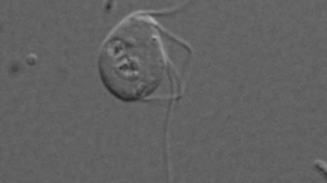
结构特殊的新型微生物
Microbe Breaks the Powerhouse Rules
结构特殊的新型微生物
A single-celled organism discovered in chinchilla droppings is the only known eukaryotic organism that lacks mitochondria-like organelles.
研究人员在南美栗鼠的粪便中发现了一种单细胞微生物,这是目前已知的唯一一类缺少类似线粒体的细胞器的真核微生物。
撰文:Christopher Intagliata
翻译:陈旭琦
审校:吴非
If you were searching for a lifeform unlike anything known to science, where would you look? Scientists at Charles University, in Prague, looked in the poop of a pet chinchilla. "They were isolating a lot of various strains from various environments—including their own pets." Anna Karnkowska, an evolutionary biologist who collaborated on the work, who is now at the University of British Columbia. "Scientists like to isolate things from everywhere possible."
如果你在寻找一种不同于任何已知科学发现的生命形式,你该从何处入手?布拉格查理大学的科学家在一种宠物——南美栗鼠的粪便中寻找线索。“他们从来自各种环境的南美栗鼠中分离出大量菌株(strains),甚至用自己的宠物做研究。”现就职于英属哥伦比亚大学的演化生物学家Anna Karnkowska参与了这项工作,在她看来,“科学家会从任何地方分离出他们想要的东西。”
They found a relative of the parasite Giardia, called Monocercomonoides. It’s eukaryotic, meaning it has organelles and a nucleus enveloping its DNA. Just like our cells, or the ones in plants, or fungi. But unlike bacteria, which don’t have those things.
他们发现寄生性贾地鞭毛虫(Giardia)的一种近亲,其名为类单边滴虫属(Monocercomonoides)。这是一种真核生物,也就是说,它有细胞器和一个含有DNA的细胞核。我们人体的细胞,以及植物、真菌中的细胞都有这套结构,而细菌则不具备。
And upon closer examination, the new critter was different from every other eukaryote known to science. Because it’s missing a key organelle—it seems to have no mitochondria.
进一步的检测表明,这一新发现的生物不同于任何已知的真核细胞,因为它缺少了关键的细胞器——它似乎没有线粒体。
You probably learned in biology class that mitochondria, let’s all say it together, are the powerhouses of the cell. They charge up energy-rich molecules, when oxygen's around. But they do other stuff too: like manufacture certain essential proteins. This newly discovered microbe, and others that live in low-oxygen environments, use different, oxygen-free pathways to make energy. But they usually still have mitochondria for that protein assembly job. The new bug apparently pulls off the protein-synthesis by using a system that it picked up from bacteria, in what’s known as a lateral gene transfer. The findings are in the journal Current Biology. [Anna Karnkowska et al., A Eukaryote without a Mitochondrial Organelle]
你可能在生物课堂中学过线粒体,简单地说,线粒体是细胞能量的来源。当四周氧气充足时,它们会让分子充满能量。但它们也参与其他的任务,例如制造某种重要的蛋白质。这一新物种和其他在低氧环境中生存的微生物一样,通过无氧途径来制造能量。但是它们通常也利用线粒体负责蛋白质的组装工作。很明显,这种新发现的微生物通过从细菌沿用下来的系统合成蛋白质,即所谓的横向基因转移。这一发现刊载于《现代生物学》(Current Biology)杂志。
Karnkowska says the microbe's ancestors probably had mitochondria at some point—then lost them once they’d acquired the bacterial system. And she says other microbes might share a similar story. "We know now that probably there are more of these weird things." And as this study suggests, they could be found in some weird places.
Karnkowska称,这一微生物的祖先可能曾拥有线粒体,但在获得细菌体系后便失去了线粒体。她还表示,其他的微生物可能有过同样的情况。“现在我们知道,可能还有更多与此类似的奇特生物。”同时这一研究显示,这些奇特的生物可能在一些奇特的地方发现。
未经书面许可任何人不得复制或镜像
京ICP备11000850号-1
 京公网安备11010502039775号
京公网安备11010502039775号 信息网络传播视听节目许可证0111611号
国家科技基础条件平台

















